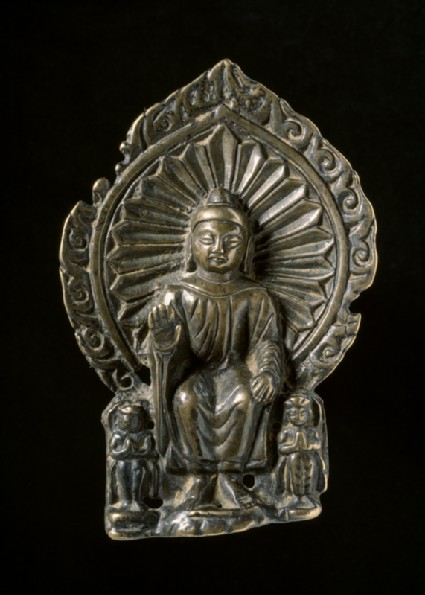Browse: 8 objects
- Reference URL
Actions
Seated figure of the Buddha with attendants
-
Details
- Associated place
- Date
- 8th - 9th century AD (AD 701 - 900)
- Associated people
-
the Buddha (active c. 560 BC - c. 486 BC) (subject)
- Material and technique
- bronze
- Dimensions
- 14.1 x 9.4 x 1.2 cm max. (height x width x depth)
- Material index
-
processed material › metal › alloy › copper alloy › bronze
- Technique index
- Object type index
- No. of items
- 1
- Credit line
- Purchased, 2001.
- Accession no.
- EA2001.152
-
Further reading
Heller, Amy, Early Himalayan Art (Oxford: Ashmolean Museum, 2008), no. 26 on p. 94, pp. 15 & 24, illus. p. 95
Location
-
- currently in research collection
Objects are sometimes moved to a different location. Our object location data is usually updated on a monthly basis. Contact the Jameel Study Centre if you are planning to visit the museum to see a particular object on display, or would like to arrange an appointment to see an object in our reserve collections.
Publications online
-

Early Himalayan Art
The head of this Buddha displays typical Chinese features, with a broad low forehead and plain hairline, without curls at the brow. However, the domed ushnisha has numerous incised circles to show curling locks of hair, outlined in pitch. The broad almond-shaped eyes appear in relief; an incised groove indicates the two lids. The brow is joined above the flat nose and there is no urna. This type of head shape and facial features were popular in sixth-century Khotan, and later Tang China, under the influence of Gandhara Buddha models [1]. The Buddha raises his right hand in the abhaya mudra of protection, the left hand resting against his knee. The hands are relatively large with thick fingers, which is also a convention of Tang Chinese Buddhist art during the period of the Tibetan occupation along the Silk Route [2].
The Buddha wears monastic garments made of a heavy fabric which falls in thick folds. This robe has a round neckline with a shawl over-collar. The robe is cut straight and wide so that as he sits, the folds of fabric gather at his waist. This position with both legs pendant and parallel is called bhadrasana, literally 'the favourable posture'. This iconography is associated most frequently with representations of Maitreya as Buddha of the Future Aeon as he descends from his heaven [3]. It is as if he were enthroned, but the back of the throne is not visible, being replaced by the peaked prabha with scrollwork of stylized flames behind his body. Radiating rays of light also appear inside the halo. The folds of the samghati are draped to the ankles. The sleeves of the robe are not gathered at the wrist, but are so wide that they hang down as far as the bare feet.
The two attendant Bodhisattvas are both wearing crowns with three low segments; no earrings are visible. Their heads are also inside circular haloes. They stand with their hands joined at heart level in namaskara mudra. Although their upper garment is not clearly visible, they have very long scarves draped in rigid curves from waist to ankle. They appear to have bracelets at the wrist, then a dhoti in thick fabric with diagonal stripes or folds over the legs.
The back of this solid cast sculpture is entirely flat. The small holes beside the Buddha's ankles suggest that it formed a plaque, for attachment to a wooden reliquary box or a wooden book-cover.
[Footnotes:]
1 Whitfield and Farrer, Caves of the Thousand Buddhas, pls. 129 A-B, for sixth century clay sculptures of the Buddha from Khotan.
2 Ibid., pl. 1, for the very large hands of the Buddha Amitabha in abhaya mudra, attributed to the eighth century, recovered from Cave 17 at Dunhuang.
3 Among Chinese examples, see Gies and Cohen, Serinde: Terre de Buddha, pl. 201: 'Apotheose de la descente de Maitreya', from northern China, dated 504 (Musee Guimet 26314).
© 2013 University of Oxford - Ashmolean Museum

